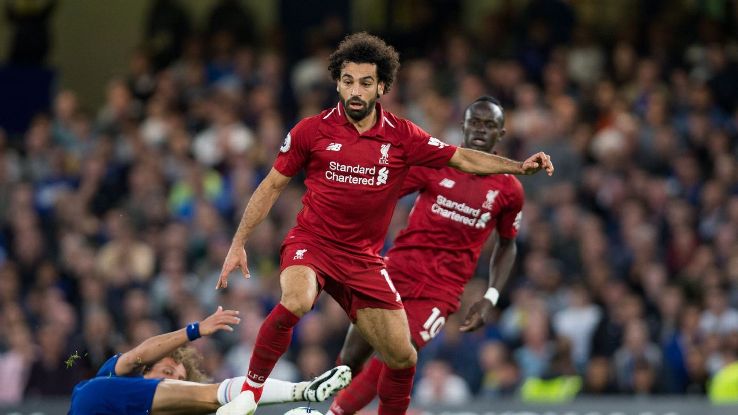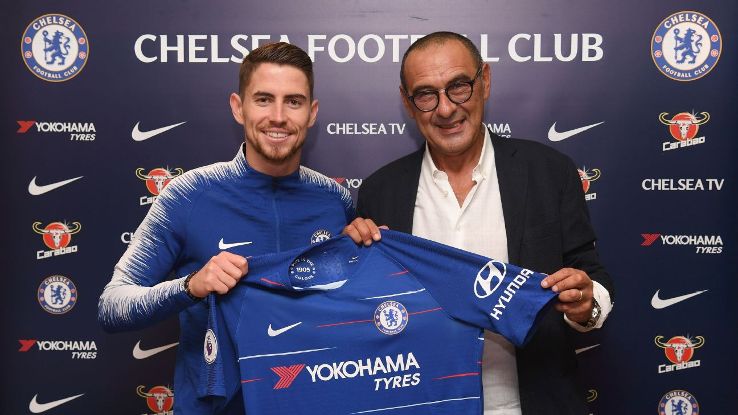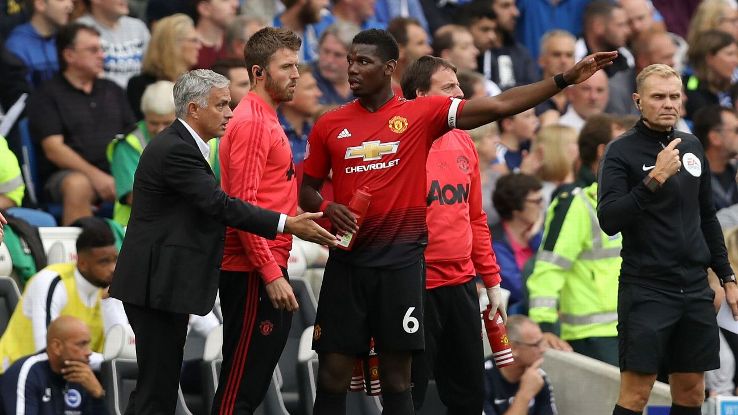
Managing a football team used to be rather straightforward. Managers were tasked with getting results — also known as the Golden Age of Jose Mourinho — without much, if any, concern about playing beautiful football. Style didn’t matter; three points did. But all that’s changing. These days, there’s a greater demand for managers to create an obvious stylistic identity for their side.
This season, for the first time in a long time, the Premier League is enjoying a new era of refreshingly diverse football: most teams are sticking to a specific style of play, unique to their side, rather than playing the same tactics as most other clubs.
What’s your club’s playing identity and how well do they stick to it? Here’s our “league table” that ranks all 20 Premier League teams according to one question: How identifiable is their game plan?
1. Liverpool
Style: counter-press and counter-attack
From Jurgen Klopp’s first game in charge nearly three years ago, it was obvious his Liverpool would be about energy, pressing and quick attacking. Now, he appears close to perfecting his approach. Improvements in defensive personnel mean Liverpool can play a high line with few problems, strength in depth has allowed the midfielders to become more energetic, and upfront there’s Europe’s most cohesive front trio of Roberto Firmino, Mohamed Salah and Sadio Mane.
Verdict: silverware still eludes Klopp at Liverpool, but he’s unquestionably created a side in his image.
2. Wolves
Style: three at the back, overlapping wing-backs
Nuno Espirito Santo has named the same starting XI in every match so far, underlining the fact that Wolves have an obvious plan, and are sticking to it. On a recent weekend of action, they were also the only side to use a three-man defence, a remarkable statistic when you consider that formation’s popularity 18 months ago, when nearly half the sides in the division used that approach.
Verdict: Wolves still require better combination play in the final third, but the quality in central midfield and the energy of their wing-backs has created a cohesive, harmonious system.
3. Watford
Style: Atletico Madrid-esque 4-4-2
The Premier League’s surprise package this season — they are sixth in the table — will likely taper off soon enough, but for a side widely expected to be battling relegation, it remains a fine start. Javi Gracia has survived from last season, a rare boost for a Watford manager, and only goalkeeper Ben Foster is a newcomer. Watford have played a compact 4-4-2 with good pressing, the wide midfielders tucking inside to protect the back four, and good interplay between the front two.
Verdict: an unusual system that utilises the squad excellently
4. Manchester City
Style: pass-and-move possession
Fresh off the back of 100 points with a possession-based approach, including by far the most technical midfield trio the Premier League has witnessed, Pep Guardiola has added the threat of Riyad Mahrez to his forward line, while Benjamin Mendy’s return after missing nearly the entire 2017-18 campaign is a huge boost. Those changes, though, mean a slight question mark about City’s optimum approach down the flanks: Are the wingers drifting in and the full-backs overlapping, or vice-versa?
Verdict: Guardiola has — again — created a revolutionary side
5. Burnley
Style: deep defence
Sean Dyche’s template is now familiar: Burnley defend deep and narrow, and they attack directly with long balls to the strikers, or through the speed of their wingers. This approach was hugely successful last season, bringing a seventh-place finish, which resulted in participation in the Europa League qualifiers. That, rather than tactical concerns, has been the reason for their slow start, and the only questions about Burnley’s identity is whether supporters eventually yearn for more positive play, and whether Dyche realises that to earn a move to a bigger job, he’ll have to demonstrate something extra.
Verdict: amongst the most consistent game plans
6. Cardiff
Style: old-school long ball
Cardiff achieved promotion to the Premier League with a remarkably low 59 percent pass completion rate last season, a reflection of Neil Warnock’s commitment to long-ball football and set-piece dominance. Inevitably, they’re the Premier League’s most direct side, essentially the new Stoke City, although their pass completion rate has improved significantly to 64 percent it is still the lowest in the division. Two of Cardiff’s four goals this season have been set plays, and that old-school approach is unlikely to change for as long as Warnock remains in charge.
Verdict: a unique tactical challenge for opponents
7. Chelsea
Style: Sarriball
Managers changing clubs usually insist that they won’t simply attempt to transfer their old tactics onto their new club, but Maurizio Sarri has unashamedly attempted to turn Chelsea into his Napoli side, complete with Jorginho pulling the strings from deep. Having largely played defensive, counter-attacking football over the past 15 years, Chelsea have never been so positive. Questions remain, however. Will N’Golo Kante continue to be used in this box-to-box midfield role that has frustrated supporters who consider him a defensive midfielder? And how will Sarri sort the forward line? Will Olivier Giroud lead the line because of his link-up play, will Alvaro Morata return to the starting XI, or will Sarri attempt to push Eden Hazard into the forward role, as he did with Dries Mertens at Napoli? The basic philosophy is in place, but their manager has indicated that it will be next season when we see “Sarriball” at its purest.
Verdict: an obvious plan, but improvement still required

8. Bournemouth
Style: possession play
Eddie Howe remains committed to a positive, possession-based approach, which involves Bournemouth’s full-backs overlapping aggressively, and his starting XI is largely familiar from last season. The Cherries can leave themselves exposed to quick counter-attacks, as in the 4-0 defeat to Burnley this season, but approaching his sixth anniversary in his second spell at the now-named Vitality Stadium, Howe’s methods remain familiar. The only question mark is in terms of system: Howe changed his usual 4-4-2 to a 3-4-3 for the trip to Stamford Bridge, which resulted in a very different style of build-up.
Verdict: a distinct, long-standing game plan
9. Tottenham
Style: press and attack with midfield runners
Over the past couple of seasons, Tottenham would have been considered amongst the Premier League’s most clearly defined sides, with Mauricio Pochettino’s pressing philosophy working wonders in terms of both style and results. Spurs retain their overall style, but there is more uncertainty this season. Harry Kane’s sluggishness means Lucas Moura has been deployed upfront to offer speed, but this has created knock-on problems with a very narrow diamond midfield, often exposing the full-backs, particularly in the 2-1 defeat to Liverpool. There’s a question about Pochettino’s preferred central midfield combination as well, with Mousa Dembele past his prime, and it was a surprise to see this side being physically outmuscled in a 2-1 defeat to Watford, a problem they would never have encountered in the past couple of seasons.
Verdict: less cohesive than in previous seasons
10. Crystal Palace
Style: sit deep and counter
Roy Hodgson and Crystal Palace was always a good fit, not merely because of his Croydon connections. Throughout his career, Hodgson has generally focused upon deep defending and quick attacking down the flanks, the approach Palace used effectively under Tony Pulis, Sam Allardyce and, sporadically, Alan Pardew. The failed Frank de Boer experiment means Hodgson’s under little pressure from supporters to be more expansive. Palace have broadly played well this season, largely only dropping points because of poor finishing. The question marks are about the system, 4-3-3 or 4-4-2, and about the centre-forward. Christian Benteke keeps missing chances and his replacement, Jordan Ayew, is a completely different type of striker altogether.
Verdict: classic Hodgson, classic Palace
11. Fulham
Style: patient possession football
Slavisa Jokanovic’s Fulham earned rave reviews for their football last season, but positive possession football in the Premier League is a much trickier challenge than positive possession football in the Championship. The wave of new signings meant the Cottagers appeared uncertain in the first couple of weeks, and while their 4-2 victory over Burnley was impressive, there’s a concern that Fulham’s players in deeper positions are prone to mistakes. They looked better in the 1-1 draw with Watford after the departure of Kevin McDonald, the holding midfielder who epitomised their patience last season, which suggests Jokanovic might need to alter his approach in midfield.
Verdict: attractive but flawed
12. Huddersfield
Style: press and strike from set plays
David Wagner bases his approach around the classic German principles of pressing and counter-pressing, and his strategic nous ensured Huddersfield beat the drop last season, against the odds. This season the approach remains familiar, but Huddersfield don’t appear to have any genuine attacking plan in open play — all three of their goals have come from set pieces, but you sense that whereas a manager like Cardiff’s Warnock is happy with that return, Wagner will be trying to find something new.
Verdict: making the best of limited resources
13. Arsenal
Style: pass from the back, press from the front
Unai Emery’s arrival has prompted Arsenal to focus on playing out from the back, and pressing from the front. But the former has often appeared perilous and the latter was completely ineffective in Arsenal’s victory over Everton. Emery’s insistence on a high defensive line also feels incompatible with his current centre-backs, and there remain questions about the format of his attacking quartet, with no guaranteed starters in any particular role.
Verdict: perhaps Emery’s philosophy is to have less of a defined philosophy.

14. Brighton
Style: deep defending, direct attacking
Chris Hughton’s template throughout his career has largely been about defending in two banks of four in two compact lines. Hughton isn’t a manager overwhelmingly concerned with possession dominance, and his sides therefore sit deep, with a high line occasionally used for defensive, rather than offensive, reasons. It’s been the same thing this season, with only Newcastle and Cardiff averaging less possession (35.6%) Pascal Gross, Brighton’s star man last season, has played only four matches so far because of injury and tactical concerns, which has meant a shift from 4-4-1-1 to 4-1-4-1, freeing wingers Anthony Knockaert and Solly March to play higher. Knockaert has therefore taken more creative responsibility with excellent results.
Verdict: a familiar formula which usually brings survival
15. Leicester
Style: some possession, some countering
Kelechi Iheanacho’s counter-attacking goal in Leicester’s 3-1 win over Huddersfield prompted many to fondly recall the Foxes’ threat on the counter-attack throughout their title-winning campaign of 2015-16, and for as long as Jamie Vardy plays upfront, they’ll remain a threat in those situations. But the signing of James Maddison, who has been fielded as a No. 10 means Leicester’s approach is more patient and more possession-based than when Riyad Mahrez dominated their attacking play. Claude Puel’s Leicester are now a more varied, but less distinct, attacking force.
Verdict: amongst the most standard tactical styles
16. Newcastle
Style: defending in numbers
Newcastle’s season has followed a consistent pattern: 2-1 defeats to big sides (Tottenham, Chelsea, Manchester City, Arsenal) and two goalless draws away at Cardiff and Crystal Palace and a 2-0 loss to Leicester. When Newcastle are keeping a clean sheet, they’re not scoring, which suggests a problem getting the balance right between defence and attack. Rafa Benitez has set out his stall this season and defended solidly with nine outfield players in a deep, compact block, probably the optimum approach for his players this season. Attacking play has defended upon quick breaks down the flanks and crossing, but both Benitez and the supporters yearn for so much more.
Verdict: understandably pragmatic, but Newcastle will need to open up
17. Everton
Style: midfield runners
Marco Silva has earned a fine reputation despite it being unclear, to use Johan Cruyff’s categorisation, whether he’s a “football coach” or a “results coach”. The Toffees have won twice so far and while there are some positive signs in terms of attacking movement, injury problems at the back and Cenk Tosun’s lack of goalscoring have caused major problems. The attacking trio of Theo Walcott, Gylfi Sigurdsson and Richarlison have looked excellent, and Everton’s fans are content with more proactive football than under Sam Allardyce, but this side is a serious work in progress.
Verdict: improvement upon last season is enough… for now
18. West Ham
Style: chopping and changing
The Hammers started the season with a host of new players, and a new manager, Manuel Pellegrini, who is generally committed to playing possession football. But early results were dreadful, with four straight defeats and a sense that West Ham were playing too high up the pitch. Pellegrini tried 4-2-3-1, 4-4-2 and 4-4-1-1, while a switch to a 4-1-4-1 has brought a surprise win at Everton and a decent point against Chelsea. It’s too early to be sure that West Ham have turned the corner, though. There remains an identity problem at West Ham — off the pitch, as much as on it.
Verdict: still looking for an identity, on and off the pitch.
19. Southampton
Style: broadly possession football
Mark Hughes finds himself in a peculiar position. Having established himself as a manager who gets teams playing efficient and organised football in a deep block, he was appointed at Stoke City to improve the side’s footballing style — and last season, they were relegated. Now Hughes is at Southampton, where he appears to have caved to supporters’ demands to play two men upfront after frustrations with Claude Puel and Mauricio Pellegrino’s defensive tactics. It’s a peculiar switch after Southampton looked impressive towards the end of last season in a three-man defence, and doesn’t suit the nature of the squad that’s overloaded with impressive centre-backs.
Verdict: the division’s most generic side

20. Manchester United
Style: passive defending, direct attacking
The problems Jose Mourinho encounters in his third season are well-documented, but usually that’s followed a couple of campaigns of relative success. This time, Mourinho still seems no closer to assembling a cohesive side in any department. A reliable centre-back partnership remains a distant dream, questions about Paul Pogba’s role haven’t been answered, while upfront United have invested huge sums in Alexis Sanchez, who hasn’t combined regularly with his teammates. What’s the game plan? It’s hard to see and you wonder whether even Mourinho knows sometimes.
Verdict: an identity crisis
